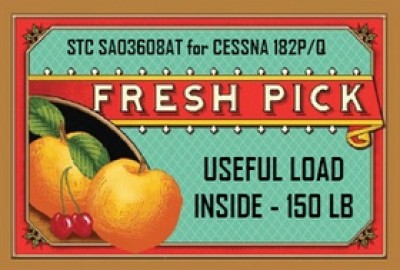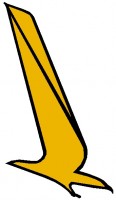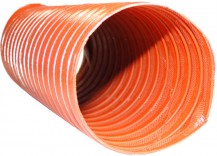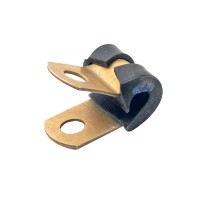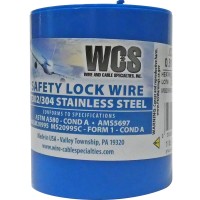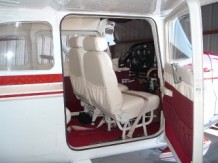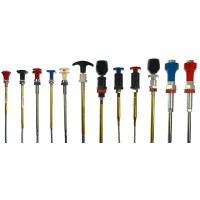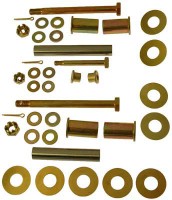Aircraft Spruce Canada
Brantford, ON Canada
Corona, CA | Peachtree City, GA
Chicago, IL | Wasilla, AK
Cessna 182 Gross Weight Increase STC
Overview
|
Now there's a new Supplemental Type Certificate (STC) that will increase the useful load of your Cessna 182P or 182Q by 150 to 160 pounds, and your ramp weight (in most cases) by 160 pounds. Best of all, this new STC requires no parts, no modifications, and no installation labor costs. One low initial price, and your airplane suddenly gains greater utility, value, and safety benefits. How did we do this? By investing in a multi-year FAA engineering, flight test, and certification program. We call the STC a Fresh Pick because no similar STC has been introduced for your airplane since it was built some 28 to 36 years ago. |
Elegibile Aircraft
- 1972 model year Cessna 182P, serial nos. 18260826 through 18261425
- 1973 model year Cessna 182P, serial nos. 18261426 through 18262465
- 1974 model year Cessna 182P, serial nos. 18262466 through 18263475
- 1975 model year Cessna 182P, serial nos. 18263476 through 18264295 (except 18263479, plus 675)
- 1976 model year Cessna 182P, serial nos. 18264296 through 18265175
- 1977 model year Cessna 182Q, serial nos. 18265176 through 18265965
- 1978 model year Cessna 182Q, serial nos. 18265966 through 18266590 (plus 18263479)
- 1979 model year Cessna 182Q, serial nos. 18266591 through 18267300
- 1980 model year Cessna 182Q, serial nos. 18267301 through 18267715 (except 18267302)
Benefits
- An increase in useful load of 150 - 160 pounds
- A potential increase in in payload of up to 160 pounds
- A ramp weight increase to 3110 pounds (up from 2950 or 2960 pounds)
- A Maximum Gross Takeoff Weight (MGTOW) of 3100 pounds (up from 2950)
- An increase of 260 to 310 nautical miles or more in range *
- An increase of 2 to 2.6 hours or more in endurance *
- The widest CG range of any fixed gear Cessna 182 ever built
* These numbers assume that the increased MGTOW is used for fuel only, and will vary with specific fuel consumption and your chosen cruise power settings.
Q&A
Please note, Aircraft Spruce Canada's personnel are not certified aircraft mechanics and can only provide general support and ideas, which should not be relied upon or implemented in lieu of consulting an A&P or other qualified technician. Aircraft Spruce Canada assumes no responsibility or liability for any issue or problem which may arise from any repair, modification or other work done from this knowledge base. Any product eligibility information provided here is based on general application guides and we recommend always referring to your specific aircraft parts manual, the parts manufacturer or consulting with a qualified mechanic.
Your ramp weight is increased to 3110 pounds, your Maximum Gross Takeoff Weight (MGTOW) to 3100 pounds. This allows you to legally take off with an additional 150 to 160 pounds of useful load or payload. If you elect to use this capability by adding about an extra 25 gallons of fuel, you'll enjoy greater range, greater endurance, and greater safety. Depending on your airplane's specific fuel consumption (higher for early 182P models, lower for 182Q's) and your selected cruise power settings, your range will increase by 260 to 310 nautical miles or more, and your endurance by 2 to 2.6 hours or more. You might also avoid an unnecessary fuel stop and the related costs in both time and money. Your loading flexibility is not limited to carrying only more fuel, since there is no Maximum Zero Fuel Weight limitation.
Your ramp weight is increased to 3110 pounds, your Maximum Gross Takeoff Weight (MGTOW) to 3100 pounds. This allows you to legally take off with an additional 150 to 160 pounds of useful load or payload. If you elect to use this capability by adding about an extra 25 gallons of fuel, you'll enjoy greater range, greater endurance, and greater safety. Depending on your airplane's specific fuel consumption (higher for early 182P models, lower for 182Q's) and your selected cruise power settings, your range will increase by 260 to 310 nautical miles or more, and your endurance by 2 to 2.6 hours or more. You might also avoid an unnecessary fuel stop and the related costs in both time and money. Your loading flexibility is not limited to carrying only more fuel, since there is no Maximum Zero Fuel Weight limitation.
Absolutely none. There are no parts required, no installations to be made, no labor costs to consider. Your IA/A&P or other maintenance provider may charge you for completing the required FAA Form 337, and signing it, thereby "returning your airplane to service." As the "installer" it is his or her responsibility to assess the compatibility of our STC with any previous major repairs or alterations that your airplane has undergone. In most cases, this should be a straightforward matter unless your airplane has had many previous mods and insufficient paperwork.
Absolutely none. There are no parts required, no installations to be made, no labor costs to consider. Your IA/A&P or other maintenance provider may charge you for completing the required FAA Form 337, and signing it, thereby "returning your airplane to service." As the "installer" it is his or her responsibility to assess the compatibility of our STC with any previous major repairs or alterations that your airplane has undergone. In most cases, this should be a straightforward matter unless your airplane has had many previous mods and insufficient paperwork.
Yes, this is a little confusing. Actually, the STC allows all four.
Since it does not increase the empty weight of your airplane (OK, less a few ounces for the required STC paperwork!), your max gross takeoff weight is increased by 150 pounds. If your airplane is a 1978 - 1980 182Q model, this represents an increase in useful load of 150 pounds as well. Your original ramp weight was 2960 before we increased it to 3110.
Should yours be a 1972 - 1976 182P or a 1977 182Q, your ramp weight was less... it has now gone from 2950 to 3110; your useful load has therefore increased by 160 pounds.
Payload is another matter entirely. Fuel is not considered payload, but is a portion of your useful load. So, for example, if you elect to use only 60 pounds of the 150 pound MGTOW increase for fuel (about 10 gallons), your payload increase is 90 pounds. If no portion of the increase is used for fuel, both your useful load and payload have increased by 150 - 160 pounds.
Yes, this is a little confusing. Actually, the STC allows all four.
Since it does not increase the empty weight of your airplane (OK, less a few ounces for the required STC paperwork!), your max gross takeoff weight is increased by 150 pounds. If your airplane is a 1978 - 1980 182Q model, this represents an increase in useful load of 150 pounds as well. Your original ramp weight was 2960 before we increased it to 3110.
Should yours be a 1972 - 1976 182P or a 1977 182Q, your ramp weight was less... it has now gone from 2950 to 3110; your useful load has therefore increased by 160 pounds.
Payload is another matter entirely. Fuel is not considered payload, but is a portion of your useful load. So, for example, if you elect to use only 60 pounds of the 150 pound MGTOW increase for fuel (about 10 gallons), your payload increase is 90 pounds. If no portion of the increase is used for fuel, both your useful load and payload have increased by 150 - 160 pounds.
Yes, this is a little confusing. Actually, the STC allows all four.
Since it does not increase the empty weight of your airplane (OK, less a few ounces for the required STC paperwork!), your max gross takeoff weight is increased by 150 pounds. If your airplane is a 1978 - 1980 182Q model, this represents an increase in useful load of 150 pounds as well. Your original ramp weight was 2960 before we increased it to 3110.
Should yours be a 1972 - 1976 182P or a 1977 182Q, your ramp weight was less... it has now gone from 2950 to 3110; your useful load has therefore increased by 160 pounds.
Payload is another matter entirely. Fuel is not considered payload, but is a portion of your useful load. So, for example, if you elect to use only 60 pounds of the 150 pound MGTOW increase for fuel (about 10 gallons), your payload increase is 90 pounds. If no portion of the increase is used for fuel, both your useful load and payload have increased by 150 - 160 pounds.
Yes and no. Many countries have reciprocal airworthiness agreements with the United States that allow an FAA issued STC to be accepted by the foreign airworthiness authorities without further showing. New Zealand and Australia are two examples. In many cases, depending on the complexity of the STC (this one is rather straightforward), certification authorities have just "accepted" the FAA STC on its face. Generally, however, the process is becoming more formalized. The European Aviation Safety Agency (EASA) for example, works closely with FAA to "validate" US STCs for Europe. EASA has now issued STC 10026913 which may be incorporated in all of the European Union (EU) countries, as well as non-EU EASA associate member countries (e.g., Switzerland and Norway). In other cases, it is suggested that you contact your National or Civil Aviation Authority (NAA or CAA) to determine what needs to be done in order to incorporate our STC.
This would be a very unusual situation. However, should none of the "authorized persons" be willing to sign your 337, your investment is safe. 100% of your purchase price will be refunded, given that you return all documents along with a written explanation of why the STC could not be incorporated, within 60 days of purchase.
Per the manufacturer, this aircraft will have no problem using the STC.

 Aircraft Spruce Canada
Aircraft Spruce Canada
